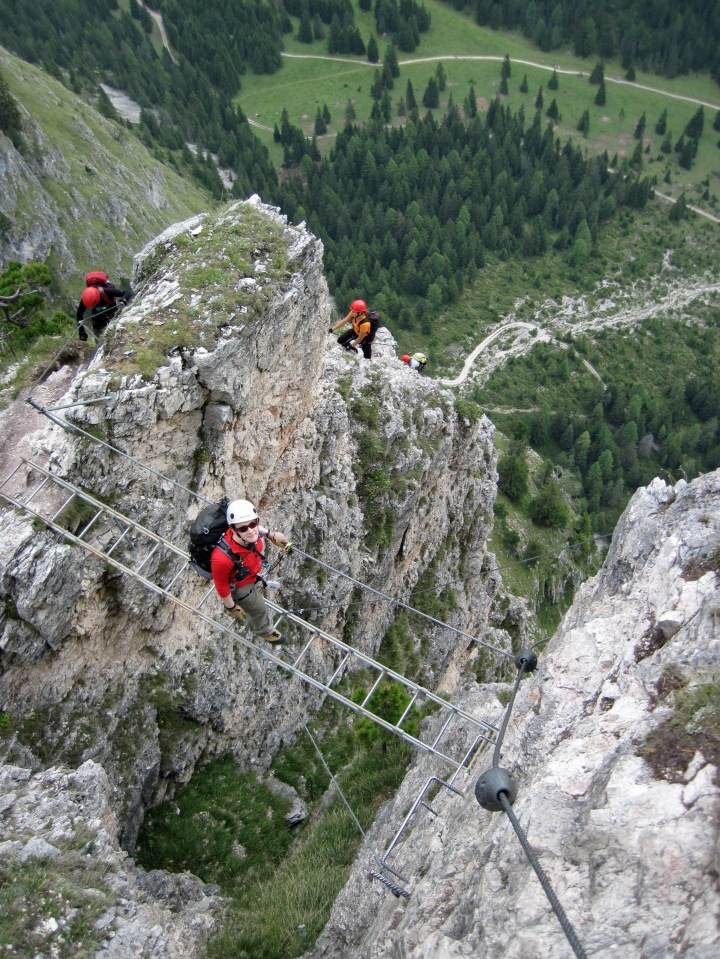
If someone asked me what causes accidents on via ferrate, I would only be able to make a few informed guesses. This is because there is surprisingly little readily accessible information on why accidents happen on vie ferrate. This concerns me because understanding why the cause of accidents is essential to preventing them. I’d like there to start a conversation about the causes and prevalence of these accidents as a way of improving understanding and helping people safely enjoy vie ferrate. As a starting point, I’ll set out what I know and suspect.
Frequency and prevalence
The only figures I’ve been able to find on the number of accidents on vie ferrate are published by the Aiut Alpin Dolomites. This is a voluntary association of seventeen mountain rescue teams that mainly operate in the Ladin Valleys of the Dolomites, an area with a high number of vie ferrate. The Aiut Alpin Dolomites figures are on the types of “interventions” they have done during the summer and winter seasons each year. These figures note that in 2013 there were 19 interventions in relation to “fixed protection climbing paths (via ferrata).” This doesn’t seem a lot to me as I imagine that every summer thousands of people must use the vie ferrate in the area the Aiut Alpin Dolomites cover. It also doesn’t seem a lot when compared to the other types of interventions these mountain rescue teams report that they were involved in that year (see chart).
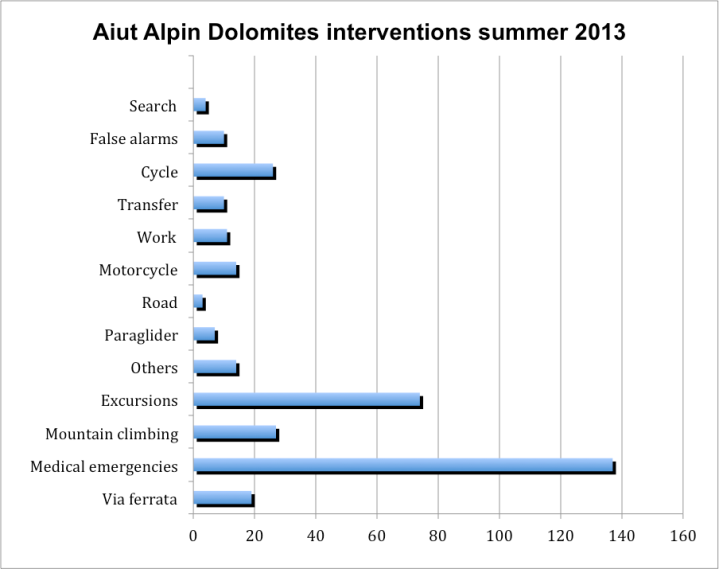
However, there is a limit from what can be said from this sort of comparison. The activities involved are quite different and so it isn’t possible, for example, to use these figures to say that climbing a via ferrata is safer or more dangerous than cycling or rock climbing. It’s also not possible to know the prevalence of accidents for each of these activities without knowing the numbers of people undertaking them. There were 19 via ferrata interventions in 2013, but this is 19 out of an unspecified number of climbs of vie ferrate in that year. Was it 19 interventions out of 10,000 climbs, 50,000 climbs or 100,000 climbs? Without this other figure it’s very hard to get a sense of how prevalent accidents are on vie ferrate.
What can be done with these figures is compare the number of via ferrata interventions by Aiut Alpin Dolomites over time to get a sense of whether accidents are occurring more or less frequently in this major area for vie ferrate climbing.
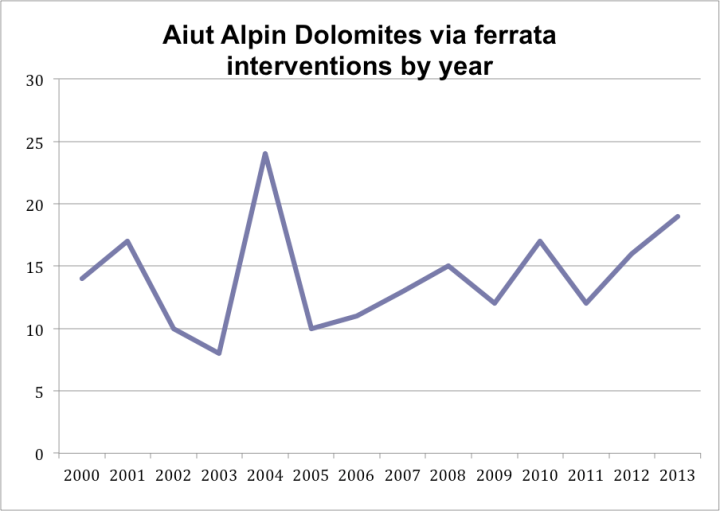
This shows no obvious trend to more or fewer interventions by Aiut Alpin Dolomites in the last 13 years. Apart from an unexplained spike in 2004 and a slight dip in 2003, the number of interventions per year has kept within a range of between 10 and 19.
It’s not possible to draw many firm conclusions from these figures as:
- the number of interventions each year are so small;
- “intervention” is not defined;
- it’s not possible to get a sense of prevalence; and
- accidents that did not require a mountain rescue intervention, or in which mountain rescue was not contacted, are presumably not included.
What the figures do indicate is that accidents are regularly happening on vie ferrate and that these accidents are serious enough for the victims to need the assistance of mountain rescue. To understand how to reduce the number of such accidents, it is necessary to understand what causes them.
Using the wrong equipment
Falling off a via ferrata involves far higher impact forces than would be encountered falling off a rock climb and specialist via ferrata sets are designed to cope with such impact forces and so arrest a fall (the Mammut website Ferrate365 website has good explanation of the impact forces involved). Yet when I’ve been climbing vie ferrate in the Dolomites I’ve regularly seen people using protective equipment that they have put together themselves out of bits of climbing equipment such as quick draws, slings or lengths of rope and standard karabiners. The chances of such a homemade set-up arresting a via ferrata fall is very low to nil. This is demonstrated by an excellent video of what happens when an 80kg person (represented in the test by a big lump of wood) falls off a via ferrata using different protective set-ups. The specialist via ferrata sets hold the fall, but the sling on the homemade set-up snaps (there is also a full length, German language version of this video).
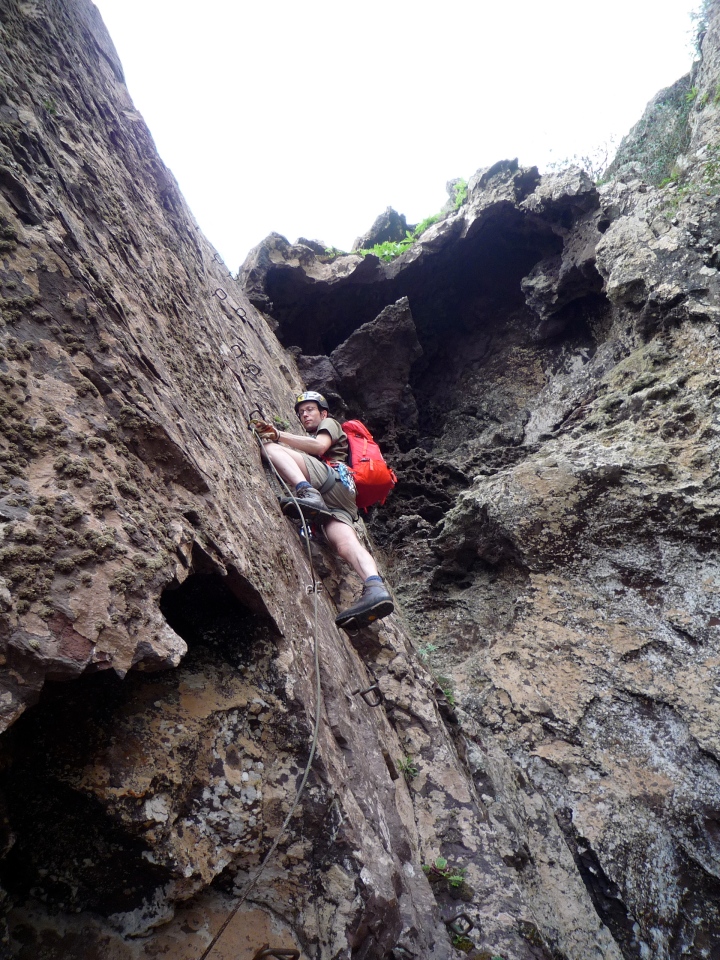
I’m guessing that the reason people try to make their own set-up rather than buying a proper set is to save money and because they are ignorant of the risks. It could be argued that such people are more likely to be first time or occasional via ferrata climbers with little rock climbing or mountaineering experience. I think this is true to an extent, as doing a via ferrata is far more accessible to inexperienced people than other aspects of climbing. However, people who don’t go rock climbing or mountaineering don’t have slings and karabiners lying around the house to use as via ferrata protection. Also, the cost of buying slings and karabiners is not dissimilar to buying a professionally made via ferrata set and so there is little financial incentive for someone to not buy a properly manufacturer via ferrata set. A more likely explanation is that most of the people who make their own via ferrata sets already have some degree of rock climbing or mountaineering experience (and so own climbing equipment) or are occasional climbers who have been lent climbing equipment. They use what is readily available because it saves a little bit of money and they don’t understand the risks. I can understand someone with no or little climbing experience making the mistake of using a homemade set-up, but it’s disquieting to think that someone with climbing experience can be ignorant of, or not care about, the potential consequences of what they are doing.
Using the right equipment badly
Ignorance or arrogance can also cause people to use the right sort of equipment in a way that means it will not work in the event of a fall.
When climbing the Via Ferrata Ivano Dibona a few years ago I saw two climbers descending a series of rock steps without their via ferrata sets being clipped to the cable. As one of these climbers climbed down, he stepped onto loose rocks that rolled and his feet slipped from under him. He then slid on his bum towards a cliff edge, coming to a stop with only his bum on the mountain and his legs sticking out into space. A little bit more momentum and he would have gone over the cliff and probably fallen to this death. This near miss could have been avoided if he had simply clipped-in.
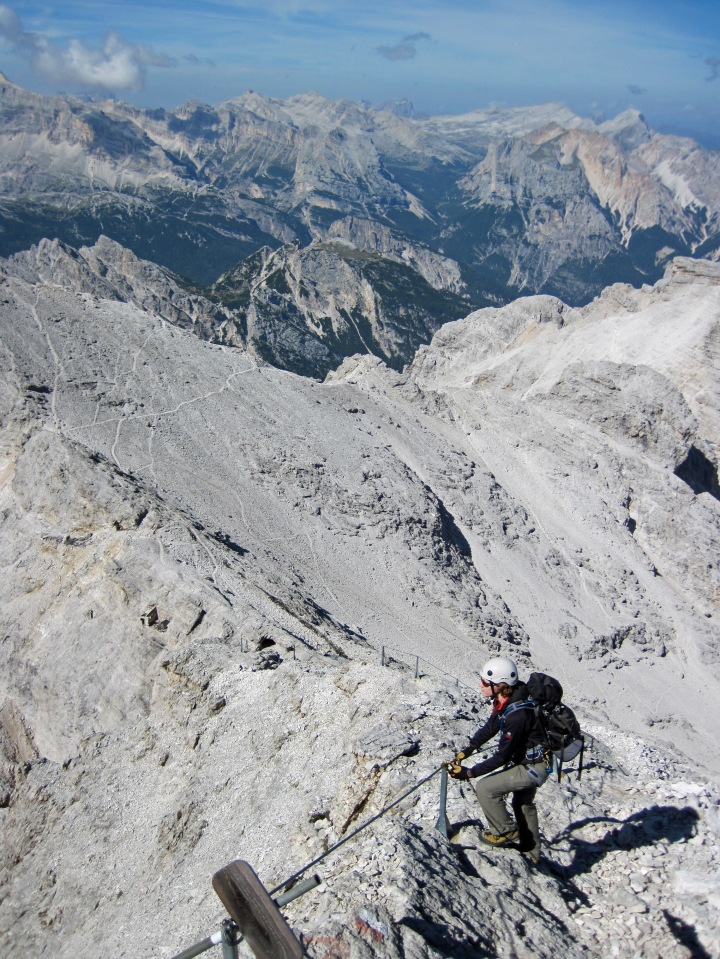
This was not the first or last climber I’ve seen climbing unclipped from the cable and I wonder if some accidents happen when one of these solo-ists has a slip. Although it’s an imperfect way of making this assessment, the clothing and equipment of these people seems to indicate that they have some experience in the mountains and climb regularly. I suspect that it is this very experience that leads to them taking the risk of not using their via ferrata sets at times as they have decided that their experience, and lack of previous accidents, means that they are less likely to stumble and fall (the dangers associated with this attitude is something I’ve written about before).
Another possible cause of serious accidents is using equipment that is too old or damaged to arrest a fall. When I climbed the Rotstock Via Ferrata last year I geared up at the base of the route at the same time as another party. The guy who appeared to be leading the group had a brand new via ferrata set (I saw him removing the manufacturer’s label) attached to a climbing harness that, from its style and faded colours, was probably over 20 years old. He was in his mid-40s and I’m guessing that he had climbed a lot when younger and had dug out his old kit to take some inexperienced friends up the Rotstock. The new via ferrata set could have saved him if he had fallen if it were not for the high probability that his harness, degraded by age, would have snapped during a fall.
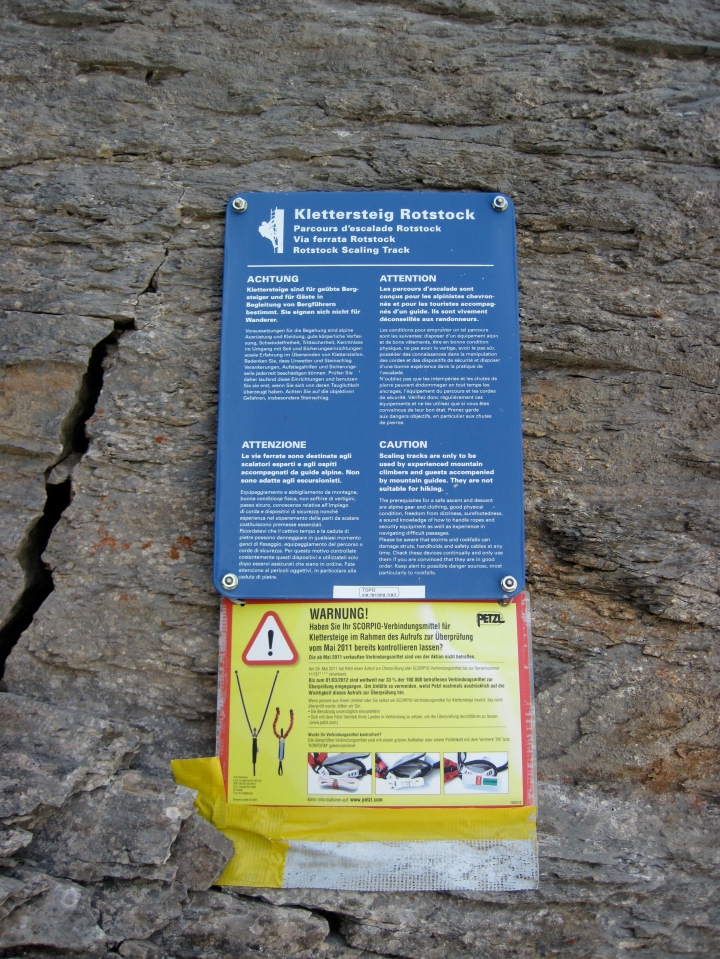
There is an interesting presentation from someone from a French mountain rescue team about a fatal accident on a via ferrata caused by a more unusual misuse of equipment (CAUTION: this slide show contains a photograph of a dead body that some people might find upsetting). The climber had tied a knot in the lanyard of an old via ferrata set in order to reduce its length and this knot reduced the lanyard’s strength. The lanyard snapped when he fell and the climber died.
Equipment failure
Equipment failure in the event of a fall is a nightmare scenario for most climbers because it has the potential to be unpredictable, unpreventable and fatal. Thankfully, testing and standards are high in the manufacture of climbing gear and most climbers are very careful to look after their gear. I don’t have any indication that it is anything other than rare for via ferrata sets to fail to arrest a fall when they are in a good condition and used properly. However, there have been a couple of times, that I know about, when someone has fallen and the via ferrata set that they were trusting failed.
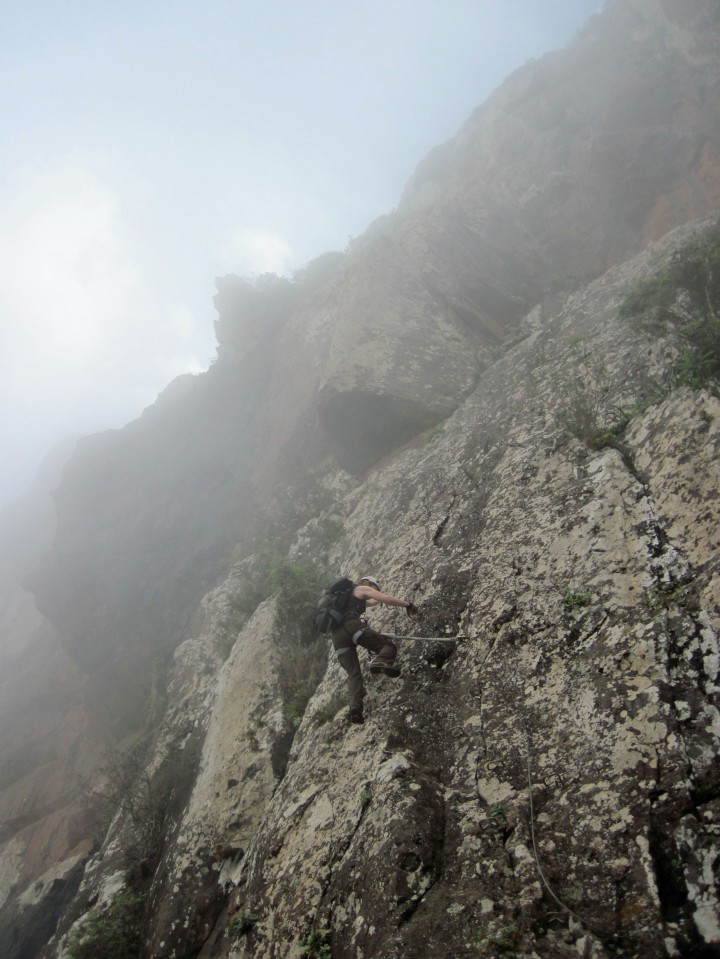
In May 2011, a young man died after falling fell to the ground from the Bastille Via Ferrata in Granoble, France. The accident appeared to have been the result of a manufacturing defect in the Petzl Scorpio lanyard that he was using and it led Petzl to recall all their Scorpio and Absorbica via ferrata sets.
The other incident occurred in August 2012 when a man died near Walchsee in Austria after he fell and the lanyards of his via ferrata set snapped. The manufacturer, Edelrid, the UIAA (Union Internationale des Associations d’Alpinisme – International Mountaineering and Climbing Federation) and the German Alpine Club stated that the accident involved the lanyards breaking due to both the intensive use they had been subjected to and the materials used in their manufacture. The German Alpine Club has said that repeated stretching of the lanyards during use led to a reduction in the strength of their fibres as the elastic and strength-bearing threads within them rubbed against each other. As the via ferrata set involved in the accident were rented, it was speculated that they had received more use than if it had been owed and used by a member of the public. This incident led to recalls of via ferrata sets with elasticated lanyards made by:
- Edelrid
- Wild Country
- AustriAlpin
- Singing Rock
- Climbing Technology
- Edelweiss
- Ocun
- Mammut
This was followed a few months later by recalls of via ferrata sets using rope-breaking systems. In both sets of recalls the issues related to intensive use of the via ferrata sets and their basic construction.
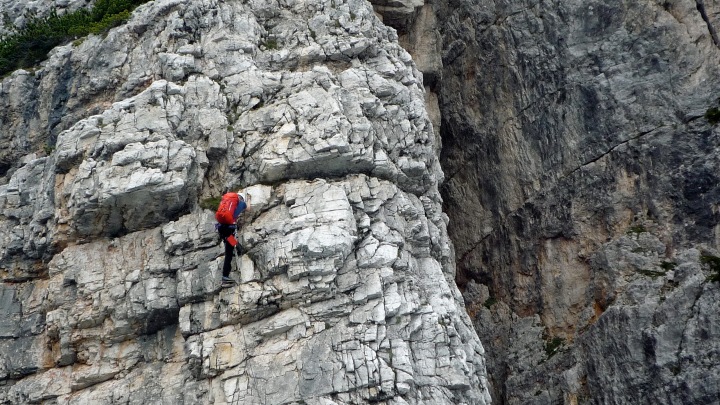
I’ve written about this before (see Recalling a Crisis and Further Recalled) and have mixed feelings about the whole affair. The swift response in these cases deserves credit. It’s probably this, the revision of safety standards, the rarity of these sorts of accidents and that the issues were not really taken up by the media that has meant this crisis doesn’t appear to have damaged consumer confidence in either manufacturers or climbing vie ferrate. Yet it’s deeply worrying that so many manufacturers had to recall so many different models of via ferrata sets because of a seeming failure of design and/or manufacture. We have to trust mountaineering equipment manufacturers to sell us via ferrata sets that work because if we ever do need to rely on a set, it really must work or we suffer potentially catastrophic consequences.
Carelessness, bad judgment, bad luck, etc.
Accidents on vie ferrate can have the same causes as accidents that happen during rock climbing, mountaineering or hiking. Carelessness, bad judgment and just plain bad luck (e.g. a falling rock) could all cause accidents on a via ferrata. Forethought, proper equipment, mindfulness, skills, experience, a critical perspective on your own judgment and heeding the advice of those with more knowledge can go a long way to preventing such accidents. Even when the accident is the result of chance, having these things can mean someone is better able to cope with the situation.
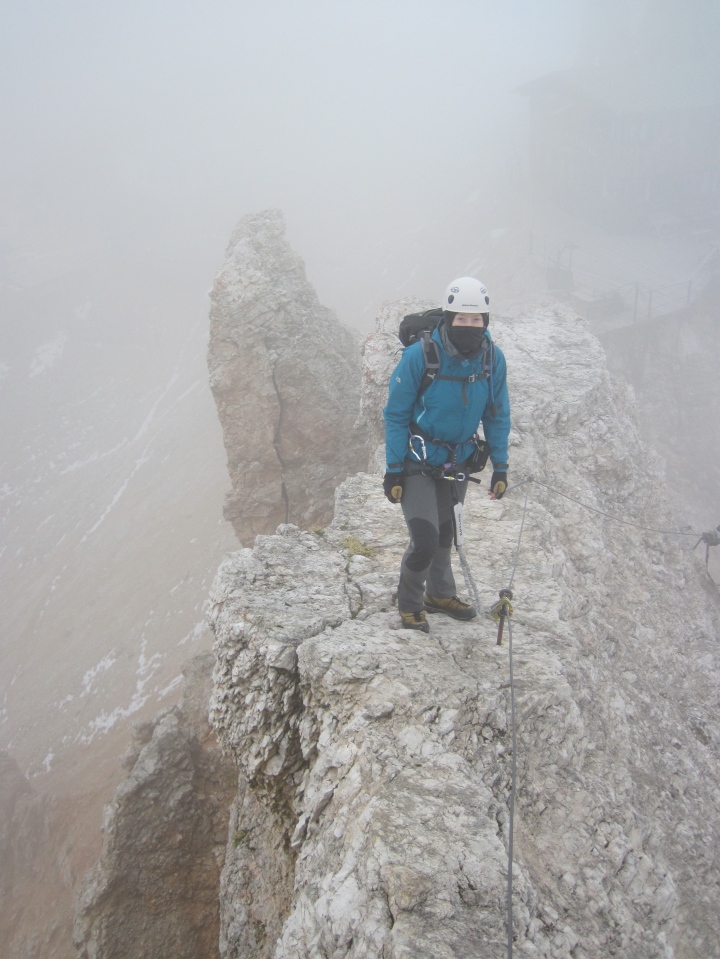
Why I can’t find out more
The trouble I have in considering why accidents happen on vie ferrate is a lack of readily accessible information. I suspect that there are two reasons for this.
The first, and simplest, explanation is that little examination has been done of why accidents happen on vie ferrate and little written about it. As climbing vie ferrate is a niche activity and (from what I can tell) accidents are fairly rare, no one may have felt the need to commission research and few first hand accounts of accidents have been published. I could only find one account from someone who had fallen on a via ferrata and in that case the cause seemed to be carelessness. I also found a video of a climber who falls a short distance, twice, as he tries to climb up an overhang In that case, it looks like the climber is just too tired to make climb up the stemples.
The second reason is that I live in the UK and don’t speak the languages of the European countries in which most vie ferrate exist. If I were fluent in Italian, French, Spanish and German then I might be able to do a comprehensive search of the news reports of vie ferrate accidents and find research published in those countries.
Unfortunately, what I have to go on is limited factual information and some speculation based on my own experiences.
Conclusions
What I can tentatively conclude is that a common theme in the potential reasons for these accidents are ignorance and arrogance. Ignorance of the risks involved in doing certain things or arrogance of the susceptibility to those risks. Another theme relates to the things that can be outside a climber’s control – the quality of equipment and chance. What these themes have in common is that knowledge and good judgment could reduce the possibility of an accident or improve how the aftermath of an accident is dealt with. Maybe improving the knowledge of people climbing vie ferrate is the best defence against accidents.
I’m interested to hear other people’s thoughts on the causes of accidents on vie ferrate and if they know of any evidence about these accidents. If we don’t know why these accidents happen, then in what can be done to stop them.
Thanks to Paolo for bringing to my attention the website of the Aiut Alpin Dolomites.
UPDATE: 30 January 2015 One of the forums on UK Climbing has an interesting thread in which people describe the via ferrata accidents they have seen or had as well as commenting on what they feel causes these accidents.

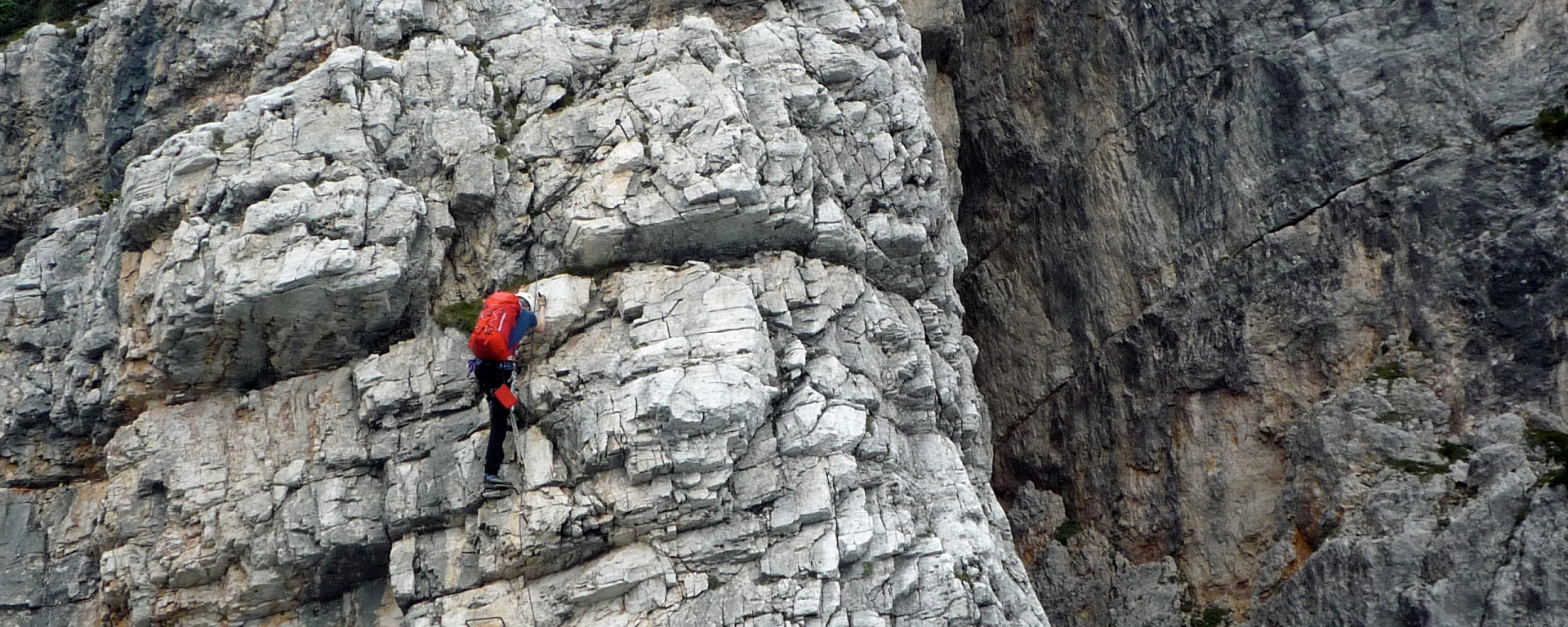
Over-ambition? We love the Dolomites, and have often observed climbers who appear not to realise how risky the paths are, even if they look easy: going up too fast, ignoring basic checks (shoes, harness, headgear), just chatting without paying attention. The mountain is unforgiving – anywhere. Appreciated your post: thanks.
Thanks. I’m glad that you liked the post.
I think over-ambition could definitely be a cause. It might also be that some people are too unaware of the risks and the mistakes they are making to realise they are being over-ambitious.
PS I love the Dolomites too and writing this post reminded me of how much I really want to go back.
The lack of statistics makes an analysis difficult as you point out. As you write, there seems to be a false sense of security, coupled with bravado / carelessness and ignorance, on Via Ferratas. I have little experience of this branch of mountaineering but I have seen groups climbing Via Ferratas in Switzerland and been horrified at the casual attitude they seem to have. I agree with your analysis and wonder what more recorded information would reveal.
Paul
Thanks.
I agree that there does seem to be a surprisingly casual attitude among some of the people who climb vie ferrate. I think this probably comes from the relative accessibility of a lot of vie ferrate combined with the limited equipment that’s required and the use of ladders, stemples, etc. to aid climbing. It’s great that vie ferrate can enable people to experience the mountains, but I think the challenge is to preserve that accessibility while improving safety.
Robin
The challenge is to preserve mountains as they should be,the problem is that people want summit pictures to show once they get back home,for that reason legendary alpine routes were covered in iron cables,ladders and stemples,now more accessible and less educative in an environmental contest which is dangerous by definition. However,how many mountain rescue members died in recent years? As for statistics,you can have a look here:http://www.cnsas.it/binary_files/riviste/Notizie_n.55_25032.pdf unfortunately almost all in German or Italian,for the Dolomiti area.
Paolo
Thanks Paolo. It’s great to have some more statistics and I’ll try to understand them (probably with the help of Google Translate and a phrasebook).
Mountain rescue do an amazing job and deserve the full thanks of everyone who enjoys the mountains. It is tragic when lives are lost in the selfless helping of others. I think that the desire to reach summits comes from something fundamental to human nature. A big question is how to enable people to try to fulfil that desire as safely as is possible for the environment and without losing the sense of achievement that comes from completing a hard climb.
Mountain conservation is a big and complex topic. I do believe that mountain environments evolve and many mountains (particularly in Europe) show the marks of a lot of human activity. Some of that activity can be damaging and some can be seen as having value (e.g. mountain communities’ unique cultures, the economic value of tourism). What to consider damage and what to consider a valuable evolution is a big debate.
Great to hear from you. Best wishes.
Yes,i agree,mountains are plenty of big questions and often giving up is the best answer. People dream of wild summits to achieve and,at the same time,the same people are very demanding in terms of safety and even comfort,unable to leave home a mental shape that doesn’t work well on a glacier or a big wall. Hard climbs call for a life of hardship,vie ferrate belong to outdoor tourism and a nice and reasonably safe experience is what we can achieve from an artificial environment.
Statistics perhaps speak louder:see how many accidents operated by mountain rescue in the Cortina area last month http://www.cnsas.veneto.it/anno2014/luglio.html?start=12 and,just to comment your words,mountain rescue is normally treated with indifference (a postcard,occa-
sionally);i don’t blame,i was often told that is an istinctive reaction to failure,people deny it.
By the way,a great rescue operation took recently place in Germany,five different countries involved for 275 hours to bring the unlucky guy back to natural light:http://www.soccorsospeleo.it/?area%20stampa+news+il-cnsas-in-appoggio-al-soccorso-bavarese but caving is a particular activity where people know and help each other more than in massive mountain tourism.
Best Wishes,always pleased to read your posts.
Paolo
I read about that rescue in Germany and think it was amazing. A super human effort and a stunning display of team work.
It’s sad that some people can treat mountain rescue members with indifference. Those few people I know who have had to rely on mountain rescue have great respect for them, as do I.
I’m glad that you like the blog. Thanks for sending the links – interesting stuff.
Best wishes
Despite some mixed weather, I just spent a good week in the gorgeous Dolomites with my wife and 11 year-old daughter and we all climbed Piz da Lech, della Trincee then finally Sandro Pertini. Arriving at the start of Trincee a family of four had just started climbing and their mid-teens daughter fell a mercifully short cable section around four sections into the start of that climb. Busy putting gear on I didn’t look up until they screamed, but believe they lost their hold on the slightly wet rock when clipping into the next section and although they could walk when they got back down after 5-10 minutes they were still very distressed and limping quite badly having banged their knee during the fall. Having seen how quickly they marched off from the cable car to the start of the VF I suspect the essential problem was an ambitious “sporty family unit”, except that day’s activity didn’t really suit at least that one family member and they probably hadn’t discovered that by trying an easier VF first. The next person up then took 30 minutes struggling to get past the same point and the one behind us struggled for 10 minutes then more sensibly gave up and climbed back down. Although Trincee has a steep start without lots of easy holds besides the cable, it wasn’t very difficult or at least not that if you’re already comfortable with a little climbing. Given that you can read the same opinion in lots of places I guess some people don’t know, but blithely assume they’ll be comfortable with the climbing because they go to the gym or something. If that were gymnastics they might have a point, otherwise…
We’re not serious climbers but do spend a couple of afternoons a month at indoor climbing walls in a flat part of England. Visiting the Dolomites for the first time last summer we decided we didn’t know anything much and it was worth paying to do our first significant VF (Tridentina) with a very pleasant Alta Badia guide who obligingly supplied us with tips and tricks about both VFs and the local culture. Immediately behind us that morning, often on my cable section, were a father and a young son with some ‘wrong’ D-I-Y zero-shock-absorbing gear and of course largely cable hauling rather than climbing using holds on the rock and using their legs to do most of the work. Doing this as a family we tend to notice and compare ourselves with other families more and for some I think there’s a kind of ‘Centre Parcs’ problem i.e. some parents are so accustomed to thrilling but supervised Health & Safety compliant activities that they now approach everything, including VFs, with much the same mindset.
Specifically on VF equipment and children the one thing that troubles me is whether any given lanyard energy absorber will provide a significant braking distance when a falling climber is a lightweight child. Some of the more recent gear apparently copes but if you look carefully that still has minimum operational weights e.g. 30Kg and much still seems to be 40-45Kg minimum. Although she’s a very competent, strong climber and the last of us who is likely to fall off anything, my normal enough weight-for-age daughter is around 35Kg. I’ve seen several younger and smaller children and suspect few of those parents have fretted about this, the pros and cons of adding a belay rope etc.
It’s both good and lucky that the girl who fell off the Via della Trincee didn’t do herself a more serious injury. I remember the start of that via ferrata being far from an easy option and I can understand how it could challenge and unnerve some people, as it did when you were there. I just hope that those who do find it challenging are as sensible as the person behind you and give up rather than commit themselves to something they can’t manage (and so probably wouldn’t enjoy anyway).
Hiring a guide seems like a great way to ease yourself into climbing via ferrata and it’s a shame more people don’t seem to do it. I imagine that it would also prevent people using DIY kits as that father and son did. It makes me shudder to think about families doing that. I also feel annoyed at the parents as the kids trust them to keep them safe, not to send them up a mountain with kit that is unlikely to catch them if they fall.
It’s a challenge though to get exactly the right equipment and I can understand how the minimum operational weights issue troubles you. The Edelrid Cable Vario (which I’m guessing you’re referencing with the 30kg minimum operational weight) looks like it might solve some parents’ problems in this respect, but you’re right that it might not for others. Belay younger and smaller kids (at the very least, through difficult sections) is the way to go.
It sounds like your daughter is doing brilliantly. I hope to be able to introduce my son to via ferrata when he is old (and heavy) enough.
Best wishes,
Robin
Interesting and complete post,reflecting a common approach to vie ferrate;talking about the Ladin Valleys,i have to throw a word in! Here is an example of tragedy:http://www.dailymail.co.uk/news/article-1193142/British-woman-plunges-300ft-death-husband-holiday-Italian-Dolomites.html please notice the important quantity of snow on summer and this is very recent:http://www.montagna.tv/cms/65681/fulmine-sul-peralba-un-morto-e-un-ferito-salva-una-bambina we have a rainy summer this year,in this case the father died for a lightning and his daughter survived;a 20/30m. EN 892 belay rope for children is wise,plus their own via ferrata gear and some normal climbing gear (karabiners,slings,quickdraws) often useless but you never know…surely in case of thunderstorms all that heavy iron and a wet rope working like an electric wire will bring you a thrilling experience,one of my main fears on via ferrata.
Paolo
Absolutely tragic accidents. More consideration and knowledge of the local conditions and the weather forecasts might have prevented them. Then again, it might not as some accidents as just freak occurrences or the result of a chance combination of lots of different factors. Being hit by lightning has to be incredibly rare, although there’s no doubt that attaching yourself to a long metal cable running up a mountain will increase the odds of being hit.
Lightning when climbing a via ferrata is a big fear for me too. I’d hate to imagine what might happen if a lightning storm came in while I was high on a via ferrata and far from an escape route. The only option would be to move as quickly as possible to try to get to a point where I could safely get away from the cable and take off my metal gear. You’re right that abseiling / rappelling out of that situation wouldn’t work too well because the wet rope would be a giant lightning conductor. Still, I totally agree that it’s worth carrying a rope and some climbing gear for emergencies and for protecting children you are climbing. The new triple-rated ropes look like they might be a good, light weight option for such an emergency rope and they might make it harder for someone to argue it’s too much weight or hassle to carry a rope. I’m certainly thinking about getting one for the next time I’m climbing via ferrata.
All the best,
Robin
I don’t think being hit by lightning in the mountains is rare at all. I’ve been struck and, when I mentioned it at our climbing club hut and we all compared notes, it turned out 1/3 of us had also been struck in the mountains. And that was without any of the metalwork in most cases. Certainly I was just hillwalking with my parents at the time.
Carol.
Wow!
I certainly imagined being struck as rare and so I’m surprised. However, I guess if you are bad weather in the mountains often enough it increases your chances.
What was it like? How did it happen?
Best wishes,
Robin
It was ‘orrid! 😉 I was being taken up onto the Welsh Aran mountains by my parents (all our holidays were hill-walking ones) when a thunderstorm came along during the ascent. We hunkered down near the path – but also near a bloody wire fence!! 😮 I had my eyes tightly shut as I was terrified of thunderstorms as a kid. Suddenly, there was the world lit up to the brightest I’d ever seen it (even with shut eyes) and a huge jolt of electric shock went from my right foot, up my right side, down my right arm and down my left leg simultaneously. I reckon I’m still here ‘cos it struck my right foot and missed the top left quarter of me out so saving my heart.
My parents, who saw the whole thing and were perfectly calm (perhaps they wanted rid of me), said the lightning ran along the wire fence top until it found my feet in the river now running down the path, and branched off to get me. They were going to continue across the mountains but I refused point-blank.
Apparently, there were 7 people killed that year by lightning in the Aran mountains – they’re a lightning magnet apparently.
Carol.
That’s horrible. It must have been scary and painful. Were you badly injured?
The only possible plus of the experience is that it makes for a good story. It’s just a shame that so many of the most interesting stories come from things going wrong or bad stuff happening.
I was actually fine – more badly frightened. But the funny thing is, I’m not as frightened of thunderstorms since then – I think I figure I’ve had my go at being struck so it’s someone else’s turn.
Definitely the best stories come from things going wrong on the hill though! 😉
I’m glad that you are fine.
You’re probably right – I think getting hit twice must be very unlikely. I don’t think this quite makes you immune (I wouldn’t try standing in a puddle, on a mountain, holding a metal pole, in a storm, for example), but maybe not too far from it.
LOL no I won’t! Actually, a Canadian Mountie was apparently struck 7 times on separate occasions in the hills – the 7th killed him though unfortunately
Another year older and heading off to some different VFs again in a few weeks, but with just a little more trepidation because the story in Paolo’s second link above was just a little too close for comfort. That was the same day t’other half, daughter and I relaxed for a while in sunshine at the top of Sandro Pertini before deciding to race back down to Selva having spotted some ominous clouds in the distance racing towards us. They quickly arrived and delivered a near continual heavy hailstorm and peals of thunder all the way down what was a less easy version of that walk when it’s carpeted with hailstones. No obviously very close lightning for us, but still too many points of similarity to that story further north-east not to reflect on what that experience did to the surviving 8 year-old bambini’s life. Then imagine my daughter in her place.
Yet here we go again. Parenting has dilemmas, but part of the job is trying to give children the opportunity to try lots of things and then encourage the ones they take to and enjoy. Climbing is one of several such things for now (12 year-old) daughter and it’s become one part of her self-image now. Then school-age life can get quite competitive and there are quite a few well-heeled children at her school, so it’s good for her to have things in her life that money alone can’t buy. As a bonus you can also scoff at the current political/press fad for telling us our children lack ‘grit’ and ‘resilience’.
But anyway… I’ve been musing on the order in which we climb VFs, subject to whether that is up or down-climbing i.e. which would be safest specifically for us? That model of the flawless, expert, strong (usually) bloke leading with the young anxious child roped up behind them like a puppy on a lead just doesn’t fit now. Unless some problem needs my greater height/reach then if my daughter can’t do it then we’re not likely to have any better luck. I think the answer is that she goes up before me and down-climbs afterwards. If there are any tricky-looking bits I make sure I’m well-anchored, at the bottom of her section if plausible, and essentially spotting before she moves. Ultimately if daughter falls towards me then the potential outcome of her hitting me seems significantly better than if it were me falling and hitting her. If anyone has a different opinion on this then I’d obviously be interested to hear it.
PS: Have just read that VF Sandro Pertini was dismantled just before xmas last year. Which is sad because I enjoyed that one most and may well have gone back, but I think a significant part of the pleasure was because of the fauna they want to protect e.g. daughter eventually gave up trying to count the Edelweiss along a few parts of the route and before we ran away from the weather I spent a while at the top watching a peregrine falcon circling around further down. It’s all very circular…
Hi.
Having become a dad myself not too long ago, I can guess at how you feel at having been in that same storm. It was a horrible thing to happen.
You ask an interesting question about whether you or your daughter goes first on a via ferrata. I’m not sure that there is an easy answer. It may be that you switch who goes in front depending on the terrain, the nature of the via ferrata and how confident you both feel about the section you are climbing.
If you go first, then you can scout out the moves so that you can offer tips. You can also set up a belay if you need to give your daughter some extra protection on a tricky section, either lowering a rope down to her or trailing the rope as you climb. If your daughter is in front, then protecting her with a rope essentially involves her lead climbing with a via ferrata back-up. Once someone is a couple of moves ahead of you, I really don’t think you can spot on a via ferrata. Her landing on you would be disastrous as you might both be injured and not able to help each other.
That said, if your daughter is as good a climber as you, then there isn’t necessarily a huge amount to be gained from you going first. Down climbing if you hit difficulties and having a good sense of when and how to use a rope are probably good strategies.
Those are my initial thoughts. The one easy alternative I can think of is to go with a guide as you did before, as they can do a lot of that thinking for you and manage belays if need be.
I only recently heard that the Sandro Pertini got been taken down. I can understand the decision, bearing in mind it was in a protected nature reserve, and I suppose it had to go. But there is still a part of me that thinks it’s a shame that a great climb has gone. The reserve is amazing and I’d like to go back to walk in it and see more of the wildlife, fauna and mountains.
Best wishes,
Robin
Yes,i climbed that via ferrata Sandro Pertini (Stevia peak,Puez-Crep dla Port) last August and was dismantled a couple of months later after years of controversy for eagles and peregrine falcon’s nesting sites. Now a logic,clean climbing route is back and that mountain is a little less tamed by mass-tourism.
Best Wishes,
Paolo
Thanks Paolo.
Hope you are well.
Best wishes,
Robin
We went to the Tirol and the weather was mixed, so it was just one serious VF in addition to the easy A/B grade Stopselzieher which is part of a long ascent of Zugspitze. We let my daughter go first both times and she just got on with it, finding sensible moves by herself without a hint of panic even during a few cable sections she later admitted were ‘a bit scary’. The serious VF was Seeben[er] which I didn’t enjoy that much because it is the ‘sporty’ type forcing you into a bit too much cable-hauling, whereas I prefer a more free-climbing type. Looking for other people’s opinions of that particular VF afterwards, I came across the DAV “Bergunfallstatistick” 2008/09 report which had this to say about it [my rough translation of the original German]:
“Seebener, a relatively short but very sporty VF, is by far the most frequent one mentioned in the reports. In one day at the end of August 2008 there were three independent cases where DAV members were too exhausted to complete the final pitch and had to be rescued”.
Perhaps that’s better now because of better access to information via the Internet etc. OEAV Ehrwald also have a prominent and very good information board at the start of the approach with all the obvious warnings and a diagram showing the various difficulty grades along the route. They rate the first ~10m and the last ~20m as grade D/E and there are a couple of long stretches of grade D between those ends, hence that problem above.
There’s also more recent DAV report from 2012/13 that says in the previous decade fatal VF accidents had decreased, but largely because of increasing popularity there had been a tenfold increase in people getting stuck and that accounted for 46% of all their VF incident reports. The report includes several ‘blocking by overwork’ cases with people explaining how they ran out of energy and confidence before the end of a route. Of the remainder 18% were falls with backup (lanyards etc.), 14% from exertion triggering physical problems (heart, circulation etc.) and 9% falls/slips/stumbles without backup. The majority of incidents apparently happened on grade C or D routes. The report’s conclusion for VFs is essentially about over-confidence i.e. people should do some sensible contingency planning, limit their objectives rather than test their limits on VFs etc.
I’m glad you managed to get some good climbing done.
Thank you for the info on the accident report – very interesting reading. By coincidence, I was doing a via ferrata in the Austria Trolley yesterday. I could certainly see how on sport routes that people could tire or lose their nerve and fall or get stuck. I was impressed with the information and signage. There were even occasional signs with mountain rescue’s phone number.
There were a couple of groups ahead of me with kids and they all had the kids climb in front. They did concern me slightly as some of the kids looked too young to be caught by the lanyards.
Best wishes,
Robin
I was that overconfident climber! My first VF was many years ago on my first continental climbing trip. Two weeks in the Dolomites saw us climbing on average three days out of four, with the forth day a rest day. On some of these rest days we did a VF, using standard climbing gear (no shock absorbers). But this was a long time ago, before fall factors and impact forces were greatly publicised for ropes, or understood by climbers (or safety legislators) In those days, as far as I was concerned a rope was there to stop you hitting the ground – its shock absorbing properties were not understood. Similarly using a sling on a VF would stop you hitting the ground – shock absorbtion didn’t cross our minds.
Of course things are different now. There’s just so much more information. I think I learned a lot during the era when lightweight karabiners and ropes were launched, mainly because until the UIAA standard for karabiners was raised to 7kN (gate open) it was possible to break them if the gate vibrated open in a fall. In order to understand why this was happening you needed to understand the properties of the rope, particularly impact forces and fall factors. Which meant I always used traditional high strength karabiners on the first two runners, and the lighter, weaker karabiners higher on the pitch where the fall factor was substantially lower, and any gear failure resulted in a longer fall rather than a ground fall. It also meant that on later VF trips I was properly equipped!
My suspicion is that many VF accidents result from the mixture of arrogance (“they are easy”) and ignorance which characterised my first few VFs. But given how much more information is available now that shouldn’t be the case.
Thanks Chris.
I guess that knowledge and understanding has moved on a long way. The climbing and via ferrata equipment of 10 or 20 years ago is a long way away from what we have now in several respects. It’s just really good that you didn’t fall off in your over-confident climber days.
Best wishes,
Robin
Hello all, I like to share an misjudgement I made on the via nirrone VF in the Dome area France, Could be helpful as there is not much written on how accidents occur. Here is one for you curious learners. First of all, Im a well trained and experienced climber and mountaineer. I climb regulary indoor and have done few expeditions at high altitude. This experienced had nothing to do however with the misjudgement I faced.
Having done some 10 VF before in my life during holidays, I had never ran into any difficulties. What I had done was all vertical, and rockclimbing passages with some small difficult steps and so. This one however was quite different, As I was on my own, I had read the route carefully many times before I left. Thinking it could never be that difficult as I was secured all the way and allways would fin a place to rest somewhere was a clear mistake.
I took the most challenging route here which I beleive was D+ containing parts overanging route. Here was the issue.
The overhang itslef was not difficult to climb, if it was not for the length. Roughly 80 meter sideways climbing in overhang with no or little feet support, after about 1/3rd my arms I was hanging on became really tired, and I looked , was surprised to see no place to rest whatso ever. Next, there were steel arms grips in the wall which I wrapped my arm around staying close to the wall the rest my other arm. The mistake in this was that my official VF set was of good quaity but the slings of it were slightly longer than my arms. If I would let myslef go to rest and hang on the set , I would be hanging off the wall due to the overhang and would not be able to reach back. Besides I was insecure that by letting go , the set would extend (go in protectiopn mode) and be twice as long, leaving me hanging in the ned to climb back up. I finally made it with some serious sweat and shaking, blaming myself not to have and extra short sling with a carabiner close to me, to make a quick rest safety (clinging your harness close to the cable, instead of being to far off) when I needed to rest my arms. So always carry a short safety stop when you do an overhang. As you dont know how quick you go into arm strength limit.!!
That was a close one. I’m not surprised that you were shaking by the end of the overhang section.
Thanks for the tip. It’s a good one. As well as overhangs, I think a sling for resting can be useful for any section of climbing where you run the risk of getting so tired that you might fall.
Best wishes,
Robin
Hello.
2 remarks about this paragraph: “In May 2011, a young man died after falling to the ground from the Bastille Via Ferrata in Granoble, France. The accident appeared to have been the result of a manufacturing defect in the Petzl Scorpio lanyard that he was using and it led Petzl to recall all their Scorpio and Absorbica via ferrata sets.”
-First: It it not Granoble but Grenoble
-The young man didn’t die. He fell to the ground from 20 or 30 meters but has partly recovered from his injuries, going almost blind. Since the accident, he has managed to hike again and even climb as competitor. He finished second in the men’s B2 visual impairment category at the 2016 IFSC Paraclimbing World Championships.
For French readers: http://france3-regions.francetvinfo.fr/auvergne-rhone-alpes/3-ans-apres-son-accident-via-ferrata-nouvelle-vie-mathieu-barbe-grenoble-417527.html
Hi,
Thanks for spotting the typo. Thanks too for the additional factual information on that accident and what happened to the man afterwards. Good to hear that he’s climbing again.
A great post – and wonderful to see a photo of you on my nemesis; VF Michielli Strobel!
I have not seen any accidents in my limited experience of climbing VF, however, I saw people with home made VF kits every single day that I spent on a VF. I also saw people unclip to go past me (arrogance) – who nearly added injury to insult when they treated me to a rockfall from above without even troubling to shout a warning.
I couldn’t guess at the numbers, but I think that ‘other people’ have a large part to play in accidents, through arrogance or ignorance. A climbing friend of mine was helicoptered off the Matterhorn when he was hit on the head by a rock dislodged by people above. That was just unlucky.
As an of piste skier, however, a common occurrence, which fills me with horror, is when I see people skiing above me. A perfect storm for triggering an avalanche to land on my head! Sometimes, it is the hapless, easy to spot as they have no backpacks – so no avalanche gear (and once they were all wearing kilts, red wigs and Tam o’ Shanters!); other times, it is people who really should know better!
Thank you. I’m glad that you liked it.
I’ve never seen a full-blown accident either, but, like you, I’ve seen quite a lot of people who concern me.
I suppose it’s a bit like driving a car. You can be a brilliant and safe driver, but all it needs is one other person to be an idiot and you end up in a car crash.
Best wishes,
Robin
The link to watch the video mentioned in this sentence, was not valid, it went to “404 not found”.
“This is demonstrated by an excellent video of what happens when an 80kg person (represented in the test by a big lump of wood) falls off a via ferrata using different protective set-ups.” I hope you can post it again!
Thank you.
Anne
Hi Anne,
Thanks for letting me know. I’ve changed the link so that it takes you to the video on YouTube (https://www.youtube.com/watch?v=Z7Y2WgtnemY).
Best wishes,
Robin
Very interesting
I’ve often wondered about VF accidents, and worried about what would happen if one fell on a steep or overhanging wall – your gear would be spent and you might not be able to reach the cable or climb back up. In the case of a six-foot slide down the cable to a stanchion, doubled before it stops you, the fall-factor is not insignificant and you would be stranded at the end of an extended lanyard, its stitches torn, rotating gently & not really enjoying the view
My own recourse is always to have a couple of cow’s tails, 20 metres of light ab rope and a pair of pulley krabs in case anybody has to be hauled up
Also, I suspect that there is an odd psychological quirk associated with VFs. When you lead a trad route, you look around for gear and usually have a fairly clear idea of how far you are run out, how likely it is that you could get into or out of trouble, what you might hit on the way down in a fall and a general idea that you really ought to be concentrating. A VF has all those bloody great cables and you are never far from a stanchion – it is hard not to feel that one’s safety has been taken care of. My wife and I tested this impression by doing the same route twice (Finanzieri) a couple of weeks apart, once with, and once without the gear. We both found that it was easier and more enjoyable without clipping (and nice to be unencumbered). Specifically, I noticed that a step off a ladder high up on the route felt awkward with VF gear but was scarcely noticeable without. Of course, it’s an easy vf, and I emphatically do not recommend this experiment to anyone who doesn’t lead Hard VS at least.
I have a very serious-minded Italian friend whose method of climbing VFs is to climb the rock and never to touch the cable except when clipping. I once tried to follow him up the VF Col. Rodella but there was no way I could do the moves and the gear was too tempting. He would always happen to look down just as I was hauling on a cable. We did the Punta Anna together last month. The descent, with sections of rather slushy snow, was fairly terrifying – my kind of thing, but not his, so I got my own back
btw, I do take issue a little with the remark above about overtaking – what else can one do on a long route? The Punta Serauta?! I suggest that one rule should be that the overtaker is always as mindful of the overtakee’s clipping needs as they are of their own, another might be that, if you solo past them, don’t grab their ankles when you fall
Thanks Peter.
I think that bits of emergency / back-up gear are really important when doing via ferrate (although, you have to know how to use them). Although, it may be that it’s the experience of trad climbing that makes this something you consider. As you say, when you’re leading trad you’re thinking about a range of things relating to your safety.
I think that the majority of people that I’ve seen overtake on via ferrate aren’t that considerate. It’s a shame / disheartening. I’ve read lots of things about via ferrate over the years, and I’m struggling to remember if I’ve ever read anything setting out how to overtake in a courteous and safe way. Maybe we just need a bit more education.
Best wishes,
Robin
Good article, thanks. I have done about 80 unique VFs in/around Switzerland, and about 120 in total up to grade E (5). In my time I have seen a few idiots: one guy climbing the Rochers de Naye VF (D/E & E) without ANY equipment! I kept out of his way so if he fell he wouldn’t hit me. One guy doing the Chaligang VF (A/B but more a T3-4 hike) with minimal equipment & a baby in a carrier on his back – he might be OK with the risk (as I was) but the baby never signed up for that! On a guided tour (D+ 4) there were people roped in front of me & one girl fell but was OK & carried on (scared the hell out of me), people not clipping, not testing equipment, using old kit, etc.
I have had a few minor problems of my own, such as forgetting to test the harness before starting Nax Belvedere (C/D) & half-way up (on a vertical) the belt came loose – so very scary. Going on the Tichodrome VF (C) during bad weather & getting stuff in a lightning storm, luckily this route has small caves to hid in & you can unclip. Doing the Gibidum Reservoir VF (C+) during poor weather when half-way round it started to pour down increasing the grade by at least +1. Falling on the Eppenberg Climbing traverse (D/E) due to over-gripping, etc.
So what have I learnt from all this? 1) People do not research routes properly in advance and seem to either underestimate the route &/or their own abilities. In CH we have v. few easy & really hard routes, so most are just intermediate/hard (C-E) & I have seen many people struggle on the harder ones. 2) ALWAYS test your equipment using a rest strap BEFORE you start, no exceptions (ever). 3) Never start a VF you are unsure you can finish (i.e., if tired, etc.), or in bad weather – it’s just not worth the risk.
A woman died on the relatively easy Gimmelwald route at Murren last year by falling off the bridge! The reports always seem to say that there was no apparent cause of the accident & that the authorities are investigating. I assume that this usually means that the person made a mistake (unclipped & slipped), or more rarely they fell & the equipment was old/untested & thus failed.
But what can be done, well some routes are being curtailed & dangerous sections removed, like at Moleson, Gibidum, Gorge Alpine, Saillon, etc. Gorge Alpine is now a guided tour only (not that this always makes it totally safe), and more signposts are going up. At the end of Saillon 2, there’s a warning that if you need a Rega air-rescue on P3, it will cost you $10,000. So perhaps more training, certification, more supervision (if possible), etc.
Finally, as you say, there should be more reporting of these accidents & the causes, esp. as a warning against all the things above. For example, when I climbed the Sulzfluz VF a while back, someone had died the week before I went, but of course no one at the staging hotel mentioned it…